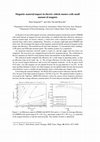Papers by Mitko Bozalakov

As the price of rare earth magnets increases, permanent magnet synchronous motors (PMSM) with sma... more As the price of rare earth magnets increases, permanent magnet synchronous motors (PMSM) with small amount of magnets become interesting, on condition that their efficiency and power density remains high. In electric vehicles, a wheel drive with a reduction needs less magnetic material than a direct drive configuration. Therefore, we design a light high speed PMSM with outer rotor. We investigate the impact of the magnetic material and the amount of magnets on the torque and efficiency. The machine has 80 mm outer diameter, 12 concentrated stator windings, 2 kW power and 4500 rpm nominal speed. The number of poles Np is optimized. An analytical reluctance network model is made [1], and the copper and iron losses are computed. The iron losses are computed based on the loss separation theory. The coefficients in the loss equation are fitted by using Epstein frame measurements on the different materials. The analytical model computes the efficiency for a wide range of operating points,...
In this article a three-phase BLDC motor controller for use in an Ultra-Light Electrical Vehicle ... more In this article a three-phase BLDC motor controller for use in an Ultra-Light Electrical Vehicle is presented. The control is performed using a Programmable Logic Device (CPLD), which doesn’t require any additional processor. In this way a robust and low-complexity control is obtained. For extending the speed range of the BLDC, a phase advance circuit is implemented as well. The
Acknowledgements The work is in collaboration with the Belgian company more@mere, info@moreatmere... more Acknowledgements The work is in collaboration with the Belgian company more@mere, info@moreatmere.com, www.bgemc.com. Abstract In this article, a high voltage two channel differential probe has been developed and tested in order to satisfy the requirements of power electronic measurements. The bandwidth of at least 10MHz is verified using a 50MHz sine wave generator. Voltage edges at 5V/ns like in real converters generated from a DC chopper are also applied and the probe is perfectly able to follow such signals. The probe is tested by using high voltage source up to 8kV DC and no coronas and flashovers were observed between the PCB layout and the components and between the components as well.





Uploads
Papers by Mitko Bozalakov